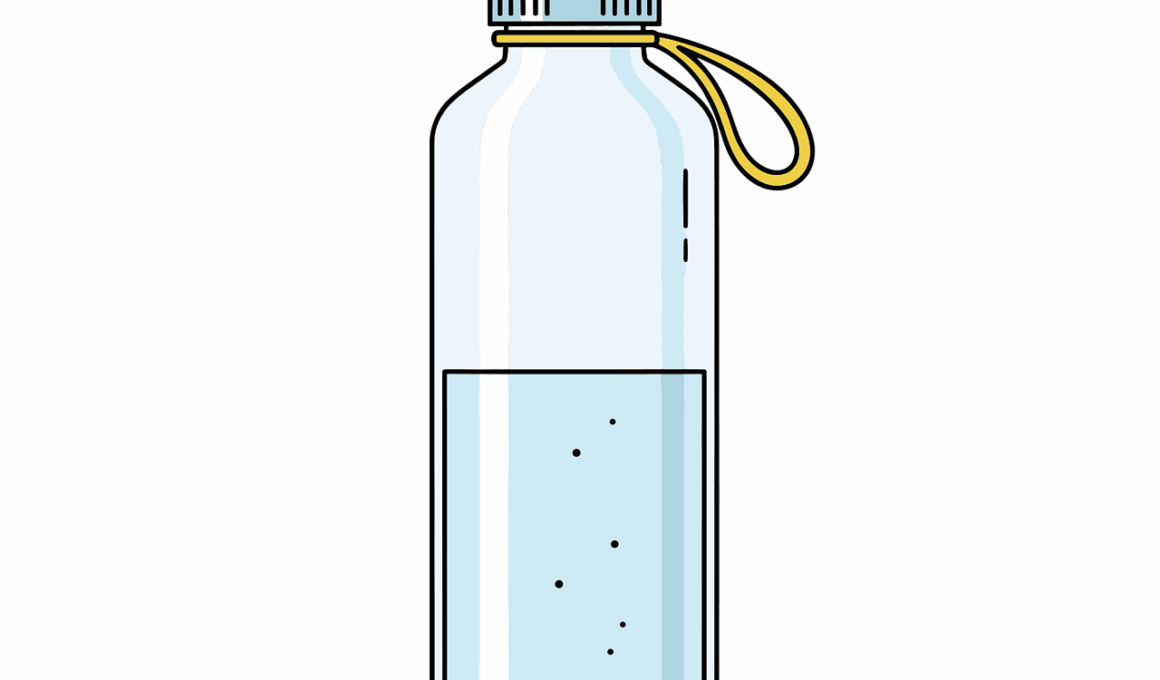Dehydration and Its Effects on Joint and Bone Health
Dehydration, a common issue often overlooked, holds significant implications for joint and bone health. Water is crucial for various bodily functions, including maintaining the lubrication and cushioning of joints. When the body becomes dehydrated, this essential lubrication diminishes, leading to increased friction during movement. As a result, individuals may experience discomfort, stiffness, and even pain in their joints. Chronic dehydration can exacerbate these symptoms over time, especially for those already suffering from joint conditions. Furthermore, the lack of adequate fluid intake particularly impacts the cartilage in the joints, which thrives on hydration to function optimally. Cartilage, composed mostly of water, serves as a protective barrier between bones. Consequently, without sufficient hydration, cartilage health declines, heightening the risk of joint degeneration and resulting in conditions such as osteoarthritis. Therefore, it is vital to prioritize hydration as a preventative measure to promote joint and bone health. Drinking water consistently throughout the day, particularly before and after physical activities, helps to maintain proper hydration and ensure optimal joint function. Simple awareness of hydration needs is crucial for sustaining healthy joints and preventing future complications.
In addition to joint issues, dehydration significantly affects bone health, which is often underestimated by many individuals. Bone tissue, like cartilage, requires water for its maintenance and overall strength. When the body lacks sufficient hydration, the bones may become weaker and more prone to injury. Furthermore, dehydration may influence nutrient absorption in the gut, depriving bones of essential minerals such as calcium and magnesium. These minerals play a key role in bone density and strength. Consequently, proper hydration levels are vital to support the body’s ability to absorb these nutrients and keep bones healthy. It is also worth noting that chronic dehydration can disrupt metabolic processes, which ultimately impacts overall bone health. The connection between hydration and the regulation of metabolic hormones, such as parathyroid hormone, showcases how vital water is for maintaining proper bone density. To promote strong bones, it is essential to drink adequate amounts of water daily, particularly for those engaged in high-impact activities or susceptible to osteoporosis. Moreover, understanding and combating dehydration through healthy lifestyle choices fosters an environment conducive to maintaining bone strength and minimizing health risks over time.
The Importance of Hydration for Joint Lubrication
Joint lubrication is critical for maintaining healthy movement and reducing the risk of pain. Synovial fluid, which is primarily composed of water, acts as a lubricant for joints, allowing smooth motion between bones. When dehydration occurs, the production of synovial fluid declines, leading to increased friction in the joints. This can lead to inflammation and discomfort over time. Individuals who are physically active, especially athletes, are more susceptible to dehydration due to sweat loss during exercise. Thus, they may inadvertently place added stress on their joints. This highlights the importance of drinking water before, during, and after physical activity to ensure that the joints remain adequately lubricated. It is advisable to develop a habit of drinking water throughout the day rather than relying solely on thirst as an indicator. Implementing hydration strategies, such as setting reminders or carrying a water bottle, can greatly assist in maintaining optimal hydration levels. Furthermore, incorporating hydrating foods, such as fruits and vegetables, can help replenish lost fluids. Prioritizing hydration is a simple yet effective way to support joint health, enhance performance, and prevent potential injury.
It is essential to recognize the signs of dehydration early to prevent its adverse effects on joint and bone health. Symptoms may include dry mouth, fatigue, dizziness, and decreased urine output. These indicators should not be ignored, as they signal that the body is functioning sub-optimally and requires immediate hydration. In more severe cases, dehydration can lead to joint swelling or pain, which can deter movement and cause additional complications. Individuals, particularly older adults, should be proactive in monitoring their fluid intake and ensuring they consume enough water daily. It is also critical to educate oneself about the best sources of hydration, not solely in beverages but also through hydrating foods. High water-content fruits, such as watermelon and oranges, can contribute significantly to daily hydration needs. Therefore, including these foods in one’s diet can make a substantial difference in staying hydrated. Establishing a hydration routine can yield long-term benefits for joint and bone health. By fostering an understanding of hydration’s role in joint and bone maintenance, individuals can take meaningful actions towards preserving their musculoskeletal health throughout their lives.
Staying Hydrated During Physical Activities
Maintaining adequate hydration during physical activities is particularly crucial for anyone engaged in sports or rigorous workouts. The body loses water through sweat, and this loss can significantly compromise joint function and performance. Not only does dehydration increase the risk of joint pain, but it also leads to decreased stamina and an increased likelihood of injuries. Hence, it is necessary to plan hydration before, during, and after exercise. Athletes should aim to hydrate well in advance of any strenuous activity and continue to sip water throughout their workout sessions. Post-exercise hydration is equally vital, as the body needs to restore any fluids lost during the physical activity. Electrolyte-replenishing drinks can also be beneficial in situations where significant amounts of fluid have been lost. Moreover, being aware of individual hydration needs can differ according to the environment, intensity of exercise, and personal sweat rates. Hence, individualized hydration strategies are recommended. Through careful attention to hydration while participating in physical activities, individuals can help protect strong joints and bones, thereby leveraging optimal fitness levels and minimizing the risk of injuries.
Dehydration prevention strategies should extend beyond physical activity to encompass daily living. Individuals may overlook their fluid intake during busy days or neglect hydration in colder-weather environments, where they may still experience fluid loss through respiration. Establishing a structured hydration framework can assist in overcoming these challenges. For instance, setting specific hydration goals, such as drinking a glass of water every hour or during meals, can contribute to increased daily fluid intake. Moreover, incorporating hydration reminders through mobile apps or writing down fluid consumption can promote consistency. Educating family and friends about the importance of hydration can also create a supportive community to prioritize this health aspect. As hydration habits are developed, this will foster a culture of awareness about the need for water throughout daily life. Additionally, monitoring the color of urine can serve as an effective self-assessment tool for hydration levels, with pale yellow denoting good hydration. Consistent attention to hydration is essential in avoiding long-term adverse effects on joint and bone health while encouraging a thriving lifestyle.
The Connection Between Nutrition and Hydration
Finally, it is essential to understand the interconnectedness of nutrition and hydration. Consuming a balanced diet rich in fruits, vegetables, and whole grains not only provides essential nutrients but can also enhance hydration levels. Foods with high water content contribute directly to total fluid intake and are particularly beneficial for achieving optimal hydration. Examples include cucumbers, tomatoes, and berries, all of which contain significant water levels. Additionally, certain vitamins and minerals can play a role in hydration status; for instance, potassium regulates fluid balance in the body. Therefore, individuals should pay attention to their dietary choices to support hydration while also considering fluid intake. Education about the importance of meal planning, incorporating hydrating foods, and ensuring smooth transitions to adequate hydration can significantly improve health outcomes. Moreover, enhancing one’s understanding of food labels will enable individuals to select foods that complement their hydration needs. Consequently, combining nutritional knowledge with an emphasis on hydration can help maintain joint and bone health effectively. Ultimately, prioritizing both hydration and nutrition fosters a holistic approach toward achieving better health and well-being throughout life.
In conclusion, recognizing the importance of hydration for joint and bone health cannot be overstated. Recurrent and chronic dehydration can lead to dire consequences, including accelerated joint deterioration and weakened bones. Thus, individuals must prioritize consistent water intake and develop healthy hydration habits. Beyond just drinking plain water, individuals should consider hydrating foods and beverages rich in essential nutrients, making hydration a multifaceted strategy for improved health. Additionally, safeguarding hydration during physical activities ensures that the body remains efficient and minimizes the risks of injuries. By monitoring hydration levels daily, educating oneself and others about the adverse effects of dehydration, and implementing practical strategies, such as setting hydration reminders, individuals can take charge of their joint and bone health. Overall, a collaborative focus on hydration, nutrition, and awareness will undoubtedly lead to a healthier lifestyle. Investing time and effort in hydration will yield positive long-term outcomes, reducing the risk of joint pain and enhancing overall quality of life. The pathway to optimal hydration and health is achievable through dedication, mindfulness, and conscious decision-making in both diet and fluid intake.


